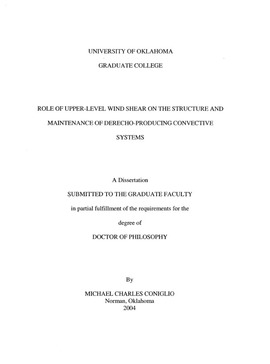| dc.contributor.advisor | Richman, Michael B., | en_US |
| dc.contributor.advisor | Stensrud, David J., | en_US |
| dc.contributor.author | Coniglio, Michael Charles. | en_US |
| dc.date.accessioned | 2013-08-16T12:20:51Z | |
| dc.date.available | 2013-08-16T12:20:51Z | |
| dc.date.issued | 2004 | en_US |
| dc.identifier.uri | https://hdl.handle.net/11244/1231 | |
| dc.description.abstract | To explore the role of upper-level shear in derecho environments, a set of two-dimensional simulations of density currents within a dry, neutrally stable environment are used to examine the ability of a cold pool to lift environmental air within a vertically sheared flow. The results confirm that the addition of upper-level shear to a wind profile with weak to moderate low-level shear increases the vertical displacement of low-level parcels despite a decrease in the vertical velocity along the cold pool interface, as suggested by previous studies. Parcels that are elevated above the surface (1-2 km) overturn and are responsible for the deep lifting in the deep-shear environments. This deep overturning caused by the upper-level shear helps to maintain the tilt of the convective systems in more complex two-dimensional and three dimensional simulations. The overturning also is shown to greatly increase the size of the convective systems in the three-dimensional simulations by facilitating the initiation and maintenance of convective cells along the cold pool. When combined with estimates of the cold pool motion and the storm-relative hodograph, these results may best be used for the prediction of the demise of strong, linear mesoscale convective systems (MCSs) and may provide a conceptual model for the persistence of strong MCSs above a surface nocturnal inversion in situations that are not forced by a low-level jet. | en_US |
| dc.description.abstract | Common large-scale environments associated with the development of derecho-producing convective systems from a large number of events are identified using statistical clustering of the 500-mb geopotential heights as guidance. The majority of the events (72%) fall into three main patterns that include a well-defined upstream trough (40%), a ridge (20%), and a zonal, low-amplitude flow (12%), which is defined as an additional warm-season pattern that is not identified in past studies of derecho environments. Through an analysis of proximity soundings, discrepancies are found in both low-level and deep-tropospheric shear parameters between observations and the shear profiles considered favorable for strong, long-lived convective systems in idealized simulations. | en_US |
| dc.format.extent | xviii, 146 leaves : | en_US |
| dc.subject | Windstorms. | en_US |
| dc.subject | Thunderstorms. | en_US |
| dc.subject | Convection (Meteorology) | en_US |
| dc.subject | Atmospheric Sciences. | en_US |
| dc.subject | Wind shear. | en_US |
| dc.title | Role of upper-level wind shear on the structure and maintenance of derecho-producing convective systems. | en_US |
| dc.type | Thesis | en_US |
| dc.thesis.degree | Ph.D. | en_US |
| dc.thesis.degreeDiscipline | School of Meteorology | en_US |
| dc.note | Source: Dissertation Abstracts International, Volume: 68-06, Section: B, page: 3631. | en_US |
| dc.note | Advisers: Michael B. Richman; David J. Stensrud. | en_US |
| ou.identifier | (UMI)AAI3270679 | en_US |
| ou.group | College of Atmospheric & Geographic Sciences::School of Meteorology | |
